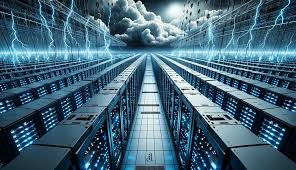The recent $1.6 billion acquisition of Bitcoin miner Core Scientific by AI cloud provider CoreWeave spotlights a critical trend: the AI revolution is creating an unprecedented hunger for energy. As data centers multiply to support AI workloads, they’re consuming power at rates comparable to small nations – triggering what experts call “the next great energy crisis.”

The Staggering Numbers Behind AI Power Appetite
- A single AI query consumes 10-15x more power than a traditional web search
- Training large language models can use more electricity than 100 homes consume in a year
- Global data center power demand is projected to double by 2026 (IEA estimates)
“The AI industry is essentially building a new digital Saudi Arabia in terms of energy consumption,” notes energy analyst Mark Williams. “But unlike oil, we can’t just pump more electrons from the ground.”
Why Crypto Miners Are Becoming AI Allies
CoreWeave’s acquisition reveals an emerging strategy: repurposing crypto infrastructure for AI. Bitcoin mining operations offer:
✔ Pre-built high-capacity power connections
✔ Existing cooling infrastructure
✔ Proven scalability for 24/7 operations
This trend is accelerating nationwide, with former mining sites in Texas, Washington and New York being converted to AI data centers.
The Coming Energy Crunch
Grid operators are warning of potential shortfalls:
- Northern Virginia (data center hub) may face 300% demand growth by 2030
- Georgia Power recently requested 17x more capacity for data centers
- Ireland has paused new data center approvals over grid concerns
Sustainable Solutions on the Horizon
Tech firms are exploring alternatives:
🔋 Small modular nuclear reactors (Microsoft recently hired a nuclear director)
🌬️ Offshore wind-powered data centers (Google testing in the North Sea)
⚡ High-efficiency chips that slash power needs
What This Means for the Future
The AI industry stands at a crossroads – its growth potential is limitless, but its power demands may soon hit physical limits. How companies and governments respond to this challenge will determine whether the AI revolution stalls or accelerates.
As CoreWeave’s CEO put it: “The next breakthrough in AI won’t come from better algorithms – it will come from whoever solves the energy equation first.”
The Bottom Line: The race to power AI is becoming as competitive as the race to build AI itself, with energy infrastructure emerging as the new battleground for tech supremacy.
How Much Power Will AI Require?
Current projections suggest AI could consume 50-100 terawatt-hours (TWh) annually by 2025—equivalent to the yearly electricity use of a small country like Sweden or Argentina. By 2030, if growth continues unchecked, AI could account for 3-5% of global electricity demand, rivaling the power consumption of entire industrial sectors. Data centers, which form the backbone of AI infrastructure, are expanding rapidly, with hyperscalers like Google, Microsoft, and Amazon investing billions in new facilities. Each next-generation AI data center can require as much as 500 megawatts (MW) or more—enough to power half a million homes.
What Is the Energy Demand for Artificial Intelligence?
AI’s energy demand stems from two key phases: training and inference. Training a single large language model (LLM) like GPT-5 can consume up to 50 GWh—more than the lifetime electricity use of 50 average U.S. households. Once deployed, AI inference (processing user queries) adds further strain—millions of daily ChatGPT requests already demand as much power as thousands of homes. With AI adoption accelerating in industries from healthcare to finance, global AI-related power demand is expected to triple by 2027, according to Goldman Sachs.
How Much Power Does AI Use in 2025?
In 2025, AI’s electricity consumption is forecasted to reach 80-120 TWh, driven by:
- More powerful AI models (e.g., multimodal AI, agentic systems)
- Expansion of cloud AI services (Microsoft Copilot, Google Gemini, AWS Bedrock)
- Enterprise AI adoption (custom LLMs for corporations)
This surge could strain power grids in tech hubs like Silicon Valley, Virginia, and Singapore, where data center clusters are already pushing local utilities to their limits. Some regions may face blackout risks if renewable energy and grid upgrades don’t keep pace.
Why Does AI Consume So Much Power?
AI’s massive energy appetite comes from three factors:
- Compute-Intensive Operations – Neural networks process billions of calculations per second, requiring high-performance GPUs (Nvidia H100, AMD MI300X) that draw up to 700W each.
- Cooling Needs – Data centers spend 30-40% of their power just on cooling to prevent hardware overheating.
- 24/7 Operation – Unlike traditional software, AI runs continuously, with cloud providers maintaining always-on server clusters to handle real-time requests.
Final Analysis: Can the Grid Handle AI’s Growth?
The AI industry is hurtling toward an energy reckoning. While tech giants are investing in nuclear, wind, and next-gen batteries, these solutions won’t scale fast enough to meet demand. Governments must accelerate grid modernization and clean energy projects, or risk brownouts and price surges in AI-heavy regions. Meanwhile, startups are pioneering low-power AI chips and efficient algorithms—potential game-changers if adopted widely. One thing is certain: The future of AI depends not just on smarter code, but on sustainable power.
- Apple’s iOS 26.2: Rolling Back Liquid Glass and Redefining Design Flexibility

- The AI Data Center Boom: A Double-Edged Sword for America’s Infrastructure

- Beyond Neuralink: The “Something Stranger” Max Hodak Is Building to Redraw the Boundaries of the Mind

- THe Brain’s Fitbit: Awear’s Neuroscience Wearable is Redefining Stress Management

- Amazon Leo: Amazon’s Satellite Internet Rebrand Signals


Pingback: Qualcomm Prepares Next-Gen Premium Mobile Chip